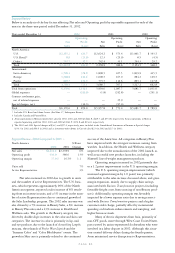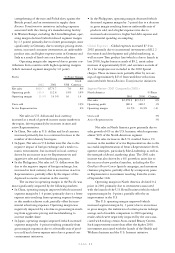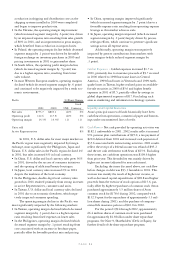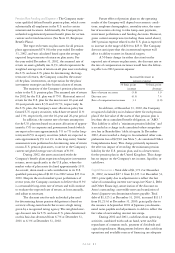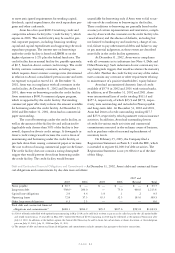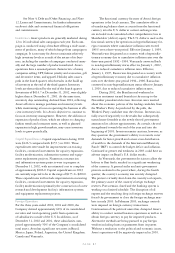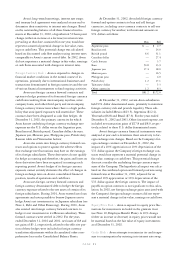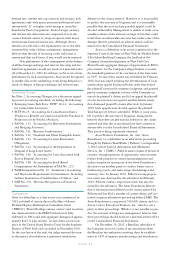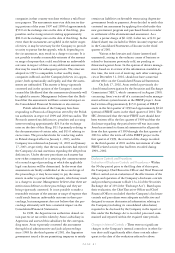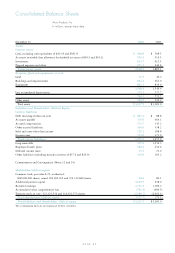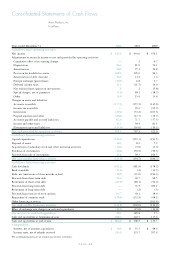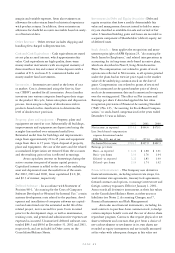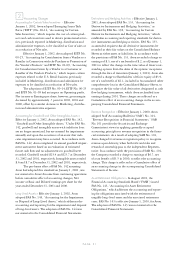Avon 2001 Annual Report Download - page 17
Download and view the complete annual report
Please find page 17 of the 2001 Avon annual report below. You can navigate through the pages in the report by either clicking on the pages listed below, or by using the keyword search tool below to find specific information within the annual report.
PAGE 41
companies in that country was done without a valid busi-
ness purpose. The assessments assert tax deficiencies dur-
ing portions of the years 1997 and 1998 of approximately
$50.0 at the exchange rate on the date of this filing, plus
penalties and accruing interest totaling approximately
$84.0 at the exchange rate on the date of this filing. In the
event that the assessments are upheld in the earlier stages
of review, it may be necessary for the Company to provide
security to pursue further appeals, which, depending on
the circumstances, may result in a charge to income. It is
not possible to make a reasonable estimate of the amount
or range of expense that could result from an unfavorable
outcome in respect of these or any additional assessments
that may be issued for subsequent periods. The structure
adopted in 1995 is comparable to that used by many
companies in Brazil, and the Company believes it is appro-
priate, both operationally and legally, and that the assess-
ments are unfounded. This matter is being vigorously
contested and in the opinion of the Company’s outside
counsel the likelihood that the assessments ultimately will
be upheld is remote. Management believes that the likeli-
hood that the assessments will have a material impact on
the Consolidated Financial Statements is also remote.
Polish subsidiaries of the Company have been
responding to Protocols of Inspection served by the Polish
tax authorities in respect of 1999 and 2000 tax audits. The
Protocols asserted tax deficiencies, penalties and accruing
interest totaling approximately $24.0 at the exchange
rates on the date of this filing: $11.0 primarily relating to
the documentation of certain sales, and $13.0 relating to
excise taxes. The procedural rules for conducting audits
in Poland changed effective January 1, 2003, and the
Company was informed on January 14, 2003 and January
17, 2003, respectively, that the tax authorities had rejected
the Company’s factual assertions regarding the alleged tax
deficiencies. Under the new procedures each matter has
now either commenced or is awaiting the commencement
of a second stage of proceeding at which the applicable
legal conclusions will be determined. In the event that
assessments are finally established at the second stage of
the proceedings, it may be necessary to pay the assess-
ments in order to pursue further appeals, which may result
in a charge to income. Management believes that there are
meritorious defenses to these proceedings and they are
being vigorously contested. It is not possible to make a
reasonable estimate of the amount or range of expense that
could result from an unfavorable outcome in these pro-
ceedings, but management does not believe that the pro-
ceedings ultimately will have a material impact on the
Consolidated Financial Statements.
In 1998, the Argentine tax authorities denied cer-
tain past excise tax credits taken by Avon’s subsidiary in
Argentina and assessed this subsidiary for the correspon-
ding taxes. Avon vigorously contested this assessment
through local administrative and judicial proceedings
since 1998. In the third quarter of 2001, the Argentine
government issued a decree permitting taxpayers to satisfy
certain tax liabilities on favorable terms using Argentine
government bonds as payment. Avon decided to settle this
contested tax assessment by applying for relief under this
new government program and purchased bonds to tender
in settlement of the aforementioned assessment. As a
result, a pretax charge of $6.4 ($3.4 after tax, or $.01 per
diluted share) was included in Other (income) expense, net
in the Consolidated Statements of Income in the third
quarter of 2001.
Various other lawsuits and claims (asserted and
unasserted), arising in the ordinary course of business or
related to businesses previously sold, are pending or
threatened against Avon. In the opinion of Avon’s manage-
ment, based on its review of the information available at
this time, the total cost of resolving such other contingen-
cies at December 31, 2002, should not have a material
adverse effect on the Consolidated Financial Statements.
On July 17, 2002, Avon settled a previously dis-
closed formal investigation by the Securities and Exchange
Commission (“SEC”), which commenced in August 2000,
concerning Avon’s write-off of a customized order manage-
ment software system known as the FIRST project. Avon
had written off approximately $15.0 (pretax) of FIRST
assets in the first quarter of 1999 and approximately $24.0
(pretax) of FIRST assets in the third quarter of 2001. The
SEC determined that the entire FIRST asset should have
been written off in the first quarter of 1999 and that the
disclosure regarding the partial write-off was inaccurate.
Avon has restated its financial statements for all periods
from the first quarter of 1999 through the first quarter of
2002 to reflect the write-off of the FIRST project in the
first quarter of 1999, the reversal of the charge recorded
in the third quarter of 2001 and the restatement of other
FIRST-related activity that had been recorded during
1999–2002.
Disclosure Controls and Procedures
Evaluation of Disclosure Controls and Procedures > Within
the 90-day period prior to the filing date of this report,
the Company’s Chief Executive Officer and Chief Financial
Officer carried out an evaluation of the effectiveness of the
design and operation of the Company’s disclosure controls
and procedures pursuant to Rule 13a-14 of the Securities
Exchange Act of 1934 (the “Exchange Act”). Based upon
their evaluation, the Chief Executive Officer and Chief
Financial Officer concluded that the Company’s disclosure
controls and procedures were adequate and effective and
designed to ensure that material information relating to
the Company (including its consolidated subsidiaries)
required to be disclosed by the Company in the reports it
files under the Exchange Act is recorded, processed, sum-
marized and reported within the required time periods.
Changes in Internal Controls > There were no significant
changes in the Company’s internal controls or in other fac-
tors that could significantly affect these controls subse-
quent to the date of the evaluation referred to above.


